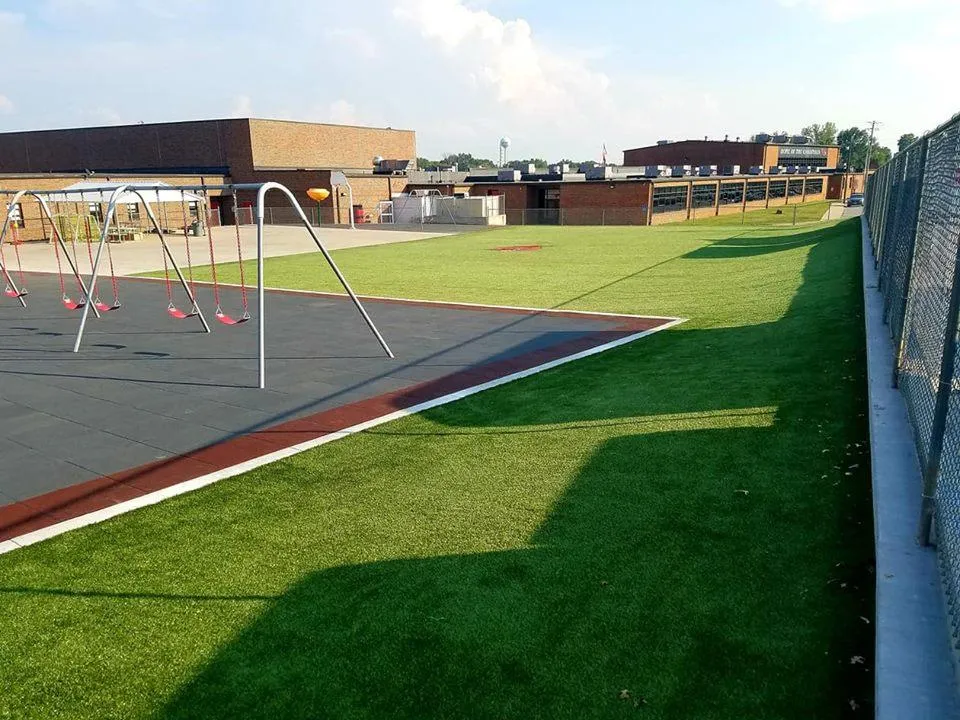972-764-8959
FREE ESTIMATES

blog
CONTACT
TURF TIMES

Commercial Turf For Playgrounds
When it comes to playground safety, the type of surface beneath our children’s feet plays a crucial role. Many parents and educators are now considering turf for playgrounds instead of natural grass. This decision not only impacts child safety but also brings a host of environmental benefits. Let’s explore some of the most compelling reasons why opting for turf can be a game-changer for our playgrounds and the planet.

1. Conserving Water Resources
One of the most significant environmental advantages of choosing turf for playgrounds is the conservation of water resources. Unlike natural grass, which requires regular watering to maintain its lush appearance, turf is designed to withstand the elements without needing excessive irrigation. This is particularly important in regions facing water scarcity. In fact, studies have indicated that switching to turf can save up to 55 gallons of water per square foot annually. That’s a substantial reduction in demand for this precious resource, allowing communities to conserve water for essential needs.
Moreover, turf can remain vibrant and usable even during drought conditions. While natural grass often turns brown and unusable under severe water restrictions, turf continues to provide a safe and enjoyable play surface for children. This reliability not only supports active play but also encourages communities to adopt water-saving practices without sacrificing recreational spaces. By making a shift to turf, we’re making a proactive choice for the environment and promoting sustainability.
2. Reducing Chemical Usage
Another compelling reason to choose turf for playgrounds is the significant reduction in chemical usage. Natural grass often necessitates the application of fertilizers, pesticides, and herbicides to maintain its health and aesthetics. These chemicals can have detrimental effects on local ecosystems and waterways, posing a threat to wildlife and water quality. By opting for turf, playgrounds can eliminate the need for such chemicals, creating a safer environment for children.
In addition to enhancing safety, reducing chemical usage also promotes healthier air quality. Turf does not require constant chemical treatments, which means fewer toxins are released into the atmosphere. This is particularly significant in urban areas where pollution levels may already be high. A cleaner, chemical-free environment allows kids to play freely while breathing easier, contributing to their overall well-being. The environmental benefits of choosing turf extend far beyond just the playground—it's a decision that nurtures the community at large.
3. Enhancing Drainage and Reducing Erosion
Turf also plays an essential role in enhancing drainage and reducing erosion, making it an excellent choice for playgrounds. Natural grass, while beneficial, can become muddy and over-saturated after heavy rain, leading to erosion and wear. Turf, on the other hand, is designed with drainage systems that facilitate quick water runoff, keeping the surface dry and safe for play. This effective drainage system minimizes puddles, reducing the risk of slips and falls.
Moreover, the construction of turf playgrounds typically involves a carefully designed base layer that helps prevent soil erosion. This is crucial in maintaining the integrity of local ecosystems by safeguarding soil health. By choosing turf, communities not only provide a reliable play surface but also contribute to the preservation of their landscape, showcasing the interconnectedness of playground safety and environmental stewardship.
4. Minimizing Carbon Footprint
In our quest to protect the environment, minimizing our carbon footprint is imperative, and turf for playgrounds can contribute significantly in this area. The maintenance of natural grass often involves the use of gas-powered lawn mowers, blowers, and other equipment that emits greenhouse gases. In stark contrast, turf requires far less frequent maintenance, resulting in a notable decrease in fossil fuel consumption. By opting for turf, communities can take meaningful steps to reduce their overall environmental impact.
As an added benefit, many modern turf systems are made from recycled materials, further lowering their carbon footprint. This innovative approach helps in reducing waste while also providing a durable and safe play surface. The combination of reduced maintenance and sustainable materials means that choosing turf can positively influence our planet in more ways than one. Making such choices should encourage us all to adopt more environmentally friendly practices in our daily lives.
5. Providing Year-Round Accessibility
When considering the perfect play surface, year-round accessibility is a crucial advantage of turf over natural grass. Natural grass can become muddy and unusable during rainy seasons, limiting play opportunities for children. Conversely, turf remains functional regardless of weather conditions, enabling children to enjoy outdoor activities all year long. This constant accessibility can lead to increased physical activity levels among kids, promoting a healthier lifestyle.
In addition to physical benefits, year-round accessibility fosters social interaction. Children can engage in play and develop friendships throughout the year, irrespective of the weather outside. Play is vital for child development, and providing consistent opportunities for outdoor play is essential. By choosing turf for playgrounds, communities are championing this principle, ensuring that children have the space they need to learn, grow, and thrive regardless of seasonal challenges.
6. Promoting Biodiversity
While it may seem counterintuitive, using turf for playgrounds can actually promote biodiversity in urban areas. Natural grass often leads to monocultures, where only a limited variety of plants thrive. On the other hand, thoughtfully designed turf systems can incorporate a mixed species of grasses and non-grass vegetation, supporting a wider range of wildlife. By attracting bees, butterflies, and other necessary pollinators, turf can contribute to healthier ecosystems.
Moreover, implementing turf playgrounds can lead to the development of ancillary green spaces. Surrounding community parks or gardens with turf play areas encourages a diverse range of plant and animal life to flourish. This interconnected approach creates vibrant ecosystems that benefit everyone, especially children who gain valuable lessons about nature and conservation through play. By enhancing biodiversity, we not only create more beautiful spaces but also contribute to the health of our planet.
7. Creating Safe Play Environments
Safety is paramount when it comes to children's playgrounds, and opting for turf can significantly contribute to creating a secure environment. Turf playgrounds are specifically engineered to provide a soft landing surface, reducing the likelihood of injuries during falls. The shock-absorbing qualities of modern turf systems mean that parents can feel more confident in the safety of their children while they explore and play.
In addition to fall protection, turf surfaces are less conducive to pests such as ticks and mosquitoes that often thrive in natural grassy areas. By minimizing the presence of these pests, turf provides a safer and more enjoyable play environment, allowing children to focus on having fun. By investing in turf for playgrounds, communities prioritize safety and ensure that children can play without the constant worry of injury or pest-related concerns.
8. Encouraging Active Lifestyles
In today’s world, where sedentary lifestyles are becoming increasingly common, encouraging active lifestyles among children is essential. Turf for playgrounds is instrumental in this effort, as it creates inviting spaces that promote recreation and physical activity. The inviting appearance of a well-kept turf field encourages children to run, jump, and play, instilling lifelong habits of health and fitness. This vibrant environment becomes an essential part of lifestyle choices that benefit children’s physical and mental well-being.
Additional physical activities encouraged by turf include organized sports and games, which require reliable surfaces. The versatility of turf allows playgrounds to host various activities, catering to different interests and abilities. As kids engage in sports, they learn teamwork, develop skills, and improve their overall physical fitness. By providing a consistent play surface and opportunities for active engagement, communities can foster healthier habits in the next generation.
9. Simplifying Maintenance Efforts
Finally, one of the most appealing advantages of turf for playgrounds is the ease of maintenance it offers. While natural grass requires constant mowing, watering, and fertilizing, turf is designed to maintain its appearance with minimal effort. This time and resource-saving feature not only alleviates the workload on caretakers and volunteers but also reduces community expenses related to playground upkeep. Such savings can be redirected toward improving other community facilities or programming, benefiting residents as a whole.
Furthermore, turf’s resilience against wear means it can withstand heavy foot traffic without the same level of degradation seen with natural grass. This not only prolongs the life of the playground but also ensures that children have a consistently beautiful and safe environment to play in. By simplifying maintenance efforts, communities can focus on providing enriching experiences for children and families while maximizing the benefits offered by the turf.

